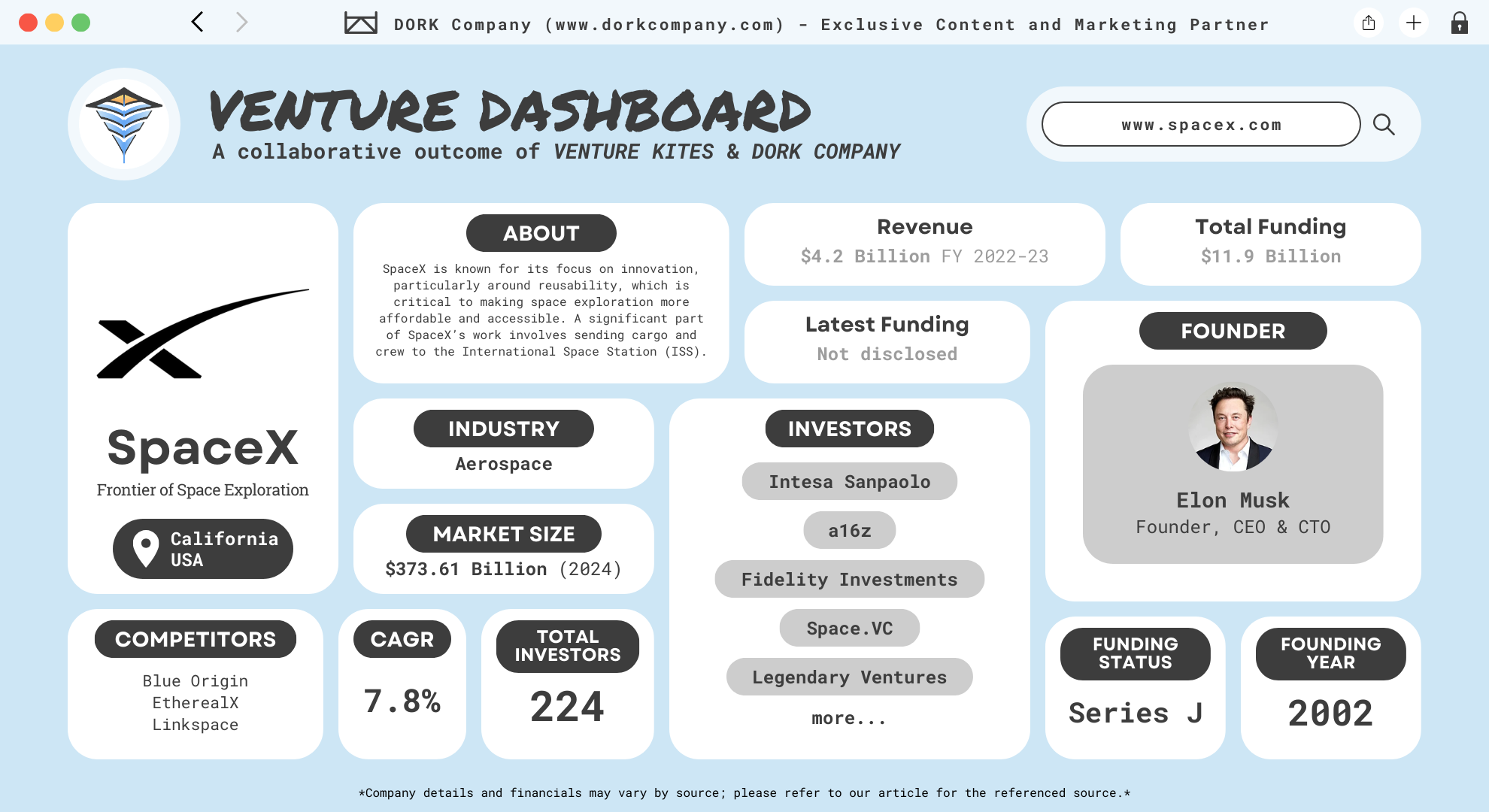SpaceX : The Ultimate Frontier of Space Exploration

The genius billionaire Elon Musk and his one-of-a-kind company, SpaceX, achieved another jaw-dropping achievement: catching a descending rocket with mechanical arms. This groundbreaking feat isn’t just a flashy stunt—it’s a bold step forward in revolutionizing space travel. Let’s dive into their thrilling journey and discover how they’re redefining what’s possible beyond our atmosphere. (Space X)
SpaceX, officially known as Space Exploration Technologies Corp., is an American aerospace company founded in 2002 by entrepreneur Elon Musk. The company was established in El Segundo, California, and its headquarters are now located in Hawthorne, California. The company is known for its focus on innovation, particularly around reusability, which is critical to making space exploration more affordable and accessible.
A significant part of their work involves sending cargo and crew to the International Space Station (ISS). The company’s Dragon spacecraft, developed to transport both crew and cargo, was the first private spacecraft to deliver cargo to the ISS. SpaceX’s Crew Dragon is now part of NASA’s Commercial Crew Program, which aims to return human spaceflight capabilities to U.S. soil.
Their achievements represent a significant shift in the aerospace industry. By introducing reusable rockets, affordable satellite launch options, and ambitious plans for human space exploration, the company is paving the way for a future where space travel is routine and accessible.
Launching Dreams: Musk’s Mission to Mars
Elon Musk founded SpaceX, or Space Exploration Technologies Corp., in 2002 with a powerful vision: to make space travel more affordable and to support the future of humanity as a multi-planetary species. Musk’s journey to launching SpaceX began much earlier, with a deep fascination with space inspired by science fiction works like Isaac Asimov’s Foundation series and Arthur C. Clarke’s 2001: A Space Odyssey. These stories fueled Musk’s belief that humans should one day inhabit multiple planets as a safeguard against potential global catastrophes, such as natural disasters or human-made crises. (Wikipedia)
Before SpaceX, Musk was already recognized as an ambitious entrepreneur. He had successfully launched ventures like Zip2, an early city guide software, and PayPal, a groundbreaking digital payments platform that eBay later acquired for $1.5 billion. This acquisition left Musk with significant funds, which he reinvested in new, ambitious projects. (Linkedin)
Struggles to Secure Affordable Rockets
In October 2001, Musk traveled to Russia to purchase refurbished intercontinental ballistic missiles (ICBMs) that could serve as launch vehicles for his Mars mission. Accompanied by engineer Jim Cantrell and friend Adeo Ressi, Musk met with Russian space organizations like NPO Lavochkin and Kosmotras. However, the Russians saw Musk as inexperienced and offered prices that were too high. Musk returned empty-handed but undeterred.
A second attempt to secure rockets in 2002 proved equally disappointing, with Musk rejecting an $8 million quote for a single launch. Frustrated, Musk decided to take matters into his own hands.
The Birth of SpaceX
With a commitment of $100 million from his PayPal proceeds, Musk founded Space Exploration Technologies Corp., or SpaceX, in March 2002. He took on the roles of CEO and chief engineer, aiming to develop cost-effective rockets that could eventually enable colonization of Mars. Their early years were challenging. The company’s first rocket, the Falcon 1, experienced several failed launch attempts, nearly bankrupting the company. However, Musk’s dedication kept SpaceX afloat.
By 2008, the persistence paid off as Falcon 1 became the first privately developed liquid-fueled rocket to reach orbit. This success earned SpaceX a $1.6 billion contract from NASA for 12 flights to the International Space Station, marking the beginning of SpaceX’s rapid ascent in the aerospace industry.
Aerospace and Space Exploration Market : The Billion-Dollar Space Race
The aerospace and space exploration market has expanded significantly, driven by advances in technology, increased government investments, and the rise of private companies. As of 2024, the aerospace industry—including commercial, defense, and space sectors—is valued at around $373.61 billion. It is expected to nearly double, reaching approximately $791.78 billion by 2034, growing at a compound annual growth rate (CAGR) of 7.8% over the next decade. (Precedence Research)
The space exploration market itself is projected to surpass $1.8 trillion by 2030. Demand for satellite services, moon and Mars exploration, and space tourism are strong growth areas. The commercial segment dominates this market, accounting for nearly half of the total share, spurred by the involvement of private companies like SpaceX, Blue Origin, and Virgin Galactic, which have capitalized on opportunities in space tourism and satellite deployment. GlobeNewswire
Governments also play a significant role, with agencies like NASA and the European Space Agency investing in exploration, research, and new technologies for long-term space missions. North America, led by the U.S., remains the largest market, with Europe and Asia Pacific regions also making significant investments. In Asia, nations like China, Japan, and India are ramping up their space programs, contributing to rapid market growth in the region.
These factors underline the aerospace and space exploration market’s robust trajectory, driven by evolving technologies, private sector engagement, and government support. This growth promises further innovations and opportunities across commercial aviation, satellite technology, and exploration.
SpaceX 101: More Than Rockets
Mission
Their mission is bold: to make life multi-planetary by establishing a human presence on Mars. This mission captures their long-term goal of extending human life beyond Earth. In line with this vision, SpaceX is dedicated to creating reusable rocket technology that could make space travel cost-effective and frequent, reducing reliance on disposable rocket stages which are typically discarded after each launch. (About SpaceX)
Vision
The company’s vision centers on becoming a pioneering spacefaring civilization, making it possible for humanity to explore, settle, and live on other planets. Their continuous innovation aims to push technological boundaries, shaping a future in which humans can safely and sustainably expand into space.
Problems They Solve
By focusing on reusability, SpaceX is addressing one of the space industry’s major problems: high costs. Reusable rockets, like the Falcon 9, land back on Earth after each launch, cutting down on material costs and making frequent launches feasible. Through such innovations, SpaceX is transforming the aerospace industry while keeping its core mission and vision in sight.
Business Model
Their business model leverages both governmental and commercial revenue streams. The company generates revenue through launching cargo, including satellites, and transporting supplies to the International Space Station. Another significant part of its business strategy is the development of Starlink, a global satellite network designed to provide high-speed internet across the world, especially in remote areas. Starlink helps diversify revenue and brings SpaceX closer to its goal of accessible space infrastructure.
The SpaceX Arsenal: From Falcons to Starships
SpaceX has built an extensive portfolio of advanced space products and services, serving both commercial and governmental sectors. Below is an overview of their key offerings:
Falcon 9
The Falcon 9 is SpaceX’s reusable workhorse rocket, designed for high-reliability, frequent launches. With a 99.2% success rate across hundreds of launches, it supports missions from satellite deployments to resupply missions for the International Space Station (ISS). Falcon 9’s reusability enables rapid turnaround and cost-efficiency, providing clients with versatile options for low Earth orbit (LEO) to geostationary transfers. (Falcon 9)
Falcon Heavy
The Falcon Heavy is currently the world’s most powerful operational rocket, designed to carry large payloads to orbit, including deep-space missions. It consists of three Falcon 9 cores and can deliver heavy cargo to destinations like the Moon and Mars. Falcon Heavy supports government and commercial clients, including NASA, with its heavy-lift capability and proven reusability. The Falcon Heavy, SpaceX’s powerful heavy-lift rocket, is capable of carrying over 63,800 kg to LEO, designed to handle high-demand missions to deep space and geostationary orbits. Its Dragon 2 variant includes Crew Dragon, designed specifically for human spaceflight under NASA’s Commercial Crew Program. The Dragon capsule can dock autonomously with the ISS, a significant feat in spacecraft technology. (Falcon Heavy)
Dragon
The Dragon spacecraft is engineered for human and cargo transportation. It has been instrumental in restoring NASA’s crew launch capabilities, safely transporting astronauts and cargo to the ISS. Dragon’s features include a pressurized capsule, unpressurized trunk, Draco thrusters for maneuvering, and an emergency escape system powered by SuperDraco engines. It supports up to seven passengers and can carry up to 6,000 kg of cargo to space and return 3,000 kg back to Earth, making it unique among commercial spacecraft. (Dragon)
Starship
Starship is SpaceX’s next-generation, fully reusable rocket, set to revolutionize interplanetary travel with missions to Mars and beyond. Standing 120 meters tall, it can carry up to 100 crew members or 250 tons of cargo. Starship’s methane-based engines and heat-resistant stainless steel structure allow for deep-space missions and lunar landings. The versatility of Starship includes configurations for crew, cargo, tanker, and lunar lander. (Starship)
Human Spaceflight
SpaceX’s human spaceflight programs, using Crew Dragon, have made commercial astronaut travel possible. SpaceX conducts NASA crew rotations to the ISS and has also expanded into commercial space tourism. With a robust launch escape system and multiple safety redundancies, SpaceX sets a high standard for private human spaceflight. (Human Spaceflight)
Rideshare
The rideshare program offers cost-effective launches for small satellites. Falcon 9’s capacity allows for multiple payloads per mission, dividing launch costs among customers. This program has helped democratize space access for smaller companies and research institutions, providing flexible schedules and pricing. (Rideshare)
Starshield
Starshield is a specialized satellite network under development, intended to support national security with advanced imaging, communications, and space-tracking capabilities. Unlike Starlink, Starshield focuses on government applications, including secure communications and Earth observation for defense clients. (Starshield)
Starlink
Starlink is SpaceX’s satellite internet constellation, delivering high-speed internet globally, particularly in remote areas. Starlink currently operates thousands of satellites in LEO, providing low-latency connectivity for underserved regions, with expansion plans that could cover over half the world’s population. With over 3,000 satellites in orbit, Starlink supports global connectivity and is especially beneficial in remote locations. (Starlink)
SpaceX provides a full suite of solutions to meet various space exploration, commercial, and defense needs. This diversity in capabilities sets SpaceX apart, supporting missions from near-Earth operations to ambitious interplanetary objectives.
Engineering for the Stars: SpaceX’s Secret Sauce
SpaceX is driven by a relentless focus on cost efficiency and technical innovation, both of which are reshaping the aerospace industry. At the core of its technology strategy are reusable rockets, advanced engines, and vertically integrated manufacturing.
Advanced Propulsion: Raptor Engines
SpaceX developed the Raptor engine, which powers Starship. It uses liquid methane and liquid oxygen, making it more efficient for deep space missions. The choice of methane also allows for the possibility of “in-situ resource utilization” on Mars, where methane can potentially be synthesized from the Martian atmosphere. This focus on sustainable propulsion design gives SpaceX a clear advantage in planning for long-term Mars missions and aligns with their commitment to efficient space travel. (SpaceX)
Merlin 1D engine
One of SpaceX’s signature technologies is the Merlin engine, which powers the Falcon 9 rocket. The Merlin 1D engine, known for its high thrust-to-weight ratio, is efficient and reliable, making it integral to both the Falcon 9 and Falcon Heavy rockets. By refining this engine and building it in-house, SpaceX significantly reduced costs compared to traditional aerospace suppliers. Vertical integration is a crucial factor here: around 80% of Falcon and Dragon components, including key technologies like engine valves and flight computers, are produced in-house. This approach keeps costs low and enables faster innovation, as the company doesn’t rely on external suppliers for critical parts. (Merlin Engine)
PICA-X heat shield
SpaceX also uses the PICA-X heat shield on its Dragon spacecraft, a proprietary material that handles the intense heat of re-entry. Initially developed in collaboration with NASA, PICA-X is less expensive and more resilient than previous heat shield materials, with potential for repeated use on missions returning from low Earth orbit and beyond. This innovation marks a significant advancement over traditional, single-use shields, making space travel more sustainable and economically viable.
Another essential aspect of SpaceX’s technological edge is its facility structure and work culture, modeled after Silicon Valley tech firms rather than traditional aerospace giants. SpaceX’s Hawthorne facility brings together engineers, production, and testing in a single location, enabling rapid development and troubleshooting. The open workspace encourages collaborative problem-solving, which has been likened to a “flash mob” of engineers mobilizing to address challenges in real-time. This streamlined structure cuts down delays and enables frequent iteration, keeping SpaceX at the forefront of space technology.
Beyond manufacturing, SpaceX has also pioneered cost-effective, rapid-turnaround launch capabilities, with rocket reusability playing a central role. The company achieved a major breakthrough in 2016 with its first Falcon 9 rocket landing, marking a milestone toward full rocket reusability. Each successful recovery of a Falcon 9’s first stage reduces the need for new rockets and lowers the cost of launches.
To Boldly Go: Landmark Missions in SpaceX’s History
First Orbital Launch
In June 2010, SpaceX’s Falcon 9 rocket achieved its first orbital launch, marking a significant milestone in private spaceflight. (Space.com)
Dragon’s Debut
Later that year, in December 2010, the Dragon spacecraft completed its maiden flight, orbiting Earth and safely returning, demonstrating SpaceX’s capability to develop reusable spacecraft.
ISS Resupply Missions
In May 2012, Dragon became the first commercial spacecraft to dock with the International Space Station (ISS), initiating a series of resupply missions that continue to support ISS operations.
Falcon 9 Reusability
SpaceX achieved a major breakthrough in December 2015 by successfully landing the Falcon 9’s first stage after launch, paving the way for reusable rocket technology.
Falcon Heavy’s Maiden Flight
In February 2018, the Falcon Heavy rocket launched its first mission, carrying a Tesla Roadster into space, showcasing SpaceX’s heavy-lift capabilities.
Crew Dragon’s First Crewed Flight
In May 2020, SpaceX launched NASA astronauts to the ISS aboard the Crew Dragon spacecraft, marking the first crewed orbital flight from U.S. soil since 2011.
Starship’s Progress
SpaceX has been developing the Starship spacecraft for missions to the Moon and Mars. In October 2024, Starship successfully completed a test flight, executing a controlled splashdown in the Indian Ocean. (New York Post)
Polaris Dawn Mission
In September 2024, SpaceX launched the Polaris Dawn mission, aiming to conduct the first commercial spacewalk and reach the highest Earth orbit ever flown by a crewed spacecraft. (People)
Starship’s Booster Recovery
In October 2024, SpaceX achieved a significant milestone by catching the Super Heavy booster using mechanical arms, known as “Mechazilla,” marking a step forward in reusable rocket technology.
Rocketing Ahead: The SpaceX Effect on the Industry
SpaceX has dramatically reduced the cost of space access. Its reusable Falcon rockets have cut launch expenses by a factor of 18. This innovation has made space more accessible to various sectors. (Harvard Business School)
By 2022, SpaceX conducted 61 out of 180 global rocket launches. This achievement underscores its significant market share. (CB Insights)
In June 2024, SpaceX prepared a tender offer valuing the company at $210 billion. This valuation set a record for a privately held U.S. firm. (New York Post)
Military Contracts
In June 2024, the U.S. Space Force selected SpaceX, along with Blue Origin and ULA, for the National Security Space Launch Phase 3 program. These contracts are potentially worth $5.6 billion over five years. (SpaceNews)
Recent Contract Wins
In October 2024, SpaceX secured nine military launch contracts valued at $733 million. This success demonstrates its competitiveness in the defense sector. (Ars Technica)
Working with NASA
SpaceX’s partnership with NASA stands out. In 2014, NASA awarded SpaceX a $2.6 billion contract to develop the Crew Dragon spacecraft for transporting astronauts to the International Space Station (ISS). This collaboration marked the return of human spaceflight launches from U.S. soil. In 2021, NASA and SpaceX signed a joint spaceflight safety agreement to enhance information sharing and maintain space safety. (NASA)
Teaming Up with Northrop Grumman
In 2024, SpaceX partnered with Northrop Grumman to develop a constellation of spy satellites for the National Reconnaissance Office. This project leverages SpaceX’s Starlink facilities and Falcon 9 rockets to deploy hundreds of satellites, enhancing U.S. intelligence capabilities. (Ars Technica)
Backers from the Beyond: Who’s Funding SpaceX’s Missions?
SpaceX, Elon Musk’s ambitious space venture, has raised around $11.9 billion across 26 rounds. The company has attracted funding from diverse sources, including corporate investors, institutional investors, and even angel investors. Over the years, SpaceX has garnered attention and substantial capital, positioning it as a key player in space technology.
Major Funding Rounds and Investors
- Series J Rounds:
SpaceX’s Series J rounds have seen some of the largest investments. For example, on January 2, 2023, the company secured $750 million from Andreessen Horowitz (a16z), reaching a valuation of $137 billion. Earlier, on June 13, 2022, another Series J round brought in $1.7 billion with support from Space.VC, Kinetic, and Mirae Asset. - Angel Investments:
Angel investors also contributed significantly. On August 25, 2022, renowned investor Ron Baron injected $100 million into SpaceX at a valuation of $127 billion. These angel investments highlight SpaceX’s appeal to high-profile individual investors. - Institutional and Corporate Backing:
SpaceX has continuously attracted institutional and corporate giants. For instance, Fidelity Investments and Sequoia Capital participated in a $1.2 billion Series J round on February 16, 2021, valuing SpaceX at $74 billion. Google also invested early in SpaceX, contributing to a $1 billion Series F round back in 2015. - Government and Corporate Grants:
Besides equity funding, SpaceX has received grants. In 2019, NASA awarded SpaceX a $3 million grant, supporting its pioneering role in space exploration. Other grants include a prize from the FCC on September 2, 2020.
Debt and Additional Financing
SpaceX has also utilized conventional debt financing. For instance, it secured $250 million from Bank of America in 2018, followed by further undisclosed amounts in 2020 and 2023 with institutions like Intesa Sanpaolo.
Valuation Growth
These investments have significantly increased SpaceX’s valuation. In May 2022, reports indicated that SpaceX was seeking to raise $1.725 billion, potentially boosting its valuation to $127 billion. By June 2024, SpaceX’s valuation had reportedly reached $210 billion. (Investopedia)
Revenue Streams
SpaceX generates revenue through various channels:
- The company provides commercial satellite launches and government missions. In 2022, SpaceX’s revenue from Starlink and rocket launches totaled $3.2 billion. (Sci-Tech Today)
- The satellite internet service has become a significant revenue source. In 2023, SpaceX generated approximately $830 million from selling Starlink terminals and $3.3 billion from providing services through those terminals, totaling $4.2 billion. (The Motley Fool)
Government Contracts
SpaceX has also secured substantial government contracts. In fiscal year 2022, NASA obligated $2.04 billion to SpaceX, making it NASA’s second-largest vendor, surpassing Boeing. (Ars Technica)
Inspired by SpaceX’s Ascent? : Launch Your Dreams
SpaceX has transformed space exploration and technology with its groundbreaking innovations. Founded by Elon Musk in 2002, SpaceX aims to make space accessible and affordable. The company designs and launches rockets that can be reused, significantly reducing the cost of space missions. SpaceX also provides satellite launches, supports the International Space Station, and is developing Starship, a spacecraft for interplanetary travel, including Mars missions.
Additionally, its Starlink satellite internet service connects remote areas globally, further diversifying its impact. SpaceX is a vision for humanity’s future in space. By solving complex aerospace challenges, SpaceX has enabled more affordable, frequent, and sustainable space missions. Their efforts help make the idea of life on Mars achievable, bringing us closer to a multi-planetary existence.
Inspired by SpaceX’s journey? Now’s the time to act. If you have a bold idea, work on it relentlessly. Even the most ambitious dreams start small, just like SpaceX did. For more stories about revolutionary companies and lessons for entrepreneurs, check out other articles on Venture Kites. They’re packed with insights, inspiration, and practical tips for anyone ready to make their mark in the world.
At a Glance with DORK Company

Dive In with Venture Kites
Lessons From Space X
Embrace Industry Disruption Boldly
The Lesson & Why it Matters: SpaceX didn’t try to fit in; it redefined spaceflight entirely. Disruption shakes up outdated practices, bringing new, often better solutions.
Implementation: Identify aspects of your industry that are resistant to change. Develop ideas that challenge the status quo and bring fresh value.
How SpaceX Implements It: SpaceX turned the space industry on its head with reusable rockets. This bold disruption lowered costs and opened doors for a new era in spaceflight.
Focus on Learning Curves, Not Shortcuts
The Lesson & Why it Matters: True innovation requires understanding each step, often through trial and error. Mastery over shortcuts builds sustainable success.
Implementation: Encourage deep learning within your team. Avoid shortcuts that compromise the learning experience and long-term growth.
How SpaceX Implements It: SpaceX’s early Falcon 1 failures were vital learning moments. Instead of rushing, they absorbed every lesson, applying it to create robust future rockets.
Create Flexibility in the Business Model
The Lesson & Why it Matters: SpaceX operates on multiple revenue streams. Flexibility allows a company to adapt and capture varied market opportunities.
Implementation: Structure your business to diversify revenue streams. Think of how each product or service can support your business in different ways.
How SpaceX Implements It: SpaceX uses both government contracts and commercial projects, including Starlink, as revenue streams, helping them weather fluctuating markets.
Build Capabilities In-House for Greater Control
The Lesson & Why it Matters: Controlling production processes reduces dependency and allows for quick adjustments. In-house expertise builds independence and innovation potential.
Implementation: Where possible, bring critical operations in-house. Invest in capabilities that allow faster response times and minimize reliance on external suppliers.
How SpaceX Implements It: SpaceX manufactures about 80% of their components in-house, allowing them to control costs, quality, and production speed.
Develop Technology that Can be Repurposed
The Lesson & Why it Matters: Multi-use technologies can be adapted across different areas, increasing their value and reducing costs in the long term.
Implementation: Invest in technologies or systems that have versatile applications. Look for ways they can benefit other products or services you offer.
How SpaceX Implements It: SpaceX’s Raptor engines are designed for both Earth and Mars, preparing them for varied missions without needing entirely new systems.
Youtube Shorts
Author Details
Creative Head – Mrs. Shemi K Kandoth
Content By Dork Company
Art & Designs By Dork Company
Instagram Feed
X (Twitter) Feed
🚀 @SpaceX is leading the charge in space exploration with reusable rockets, satellite internet, and bold visions for interplanetary travel! 🌌
— Venture Kites (@VentureKites) January 19, 2025
💡 Let’s explore how they’re revolutionizing the aerospace industry and inspiring a multi-planetary future 👇👇#SpaceX #MarsMission












